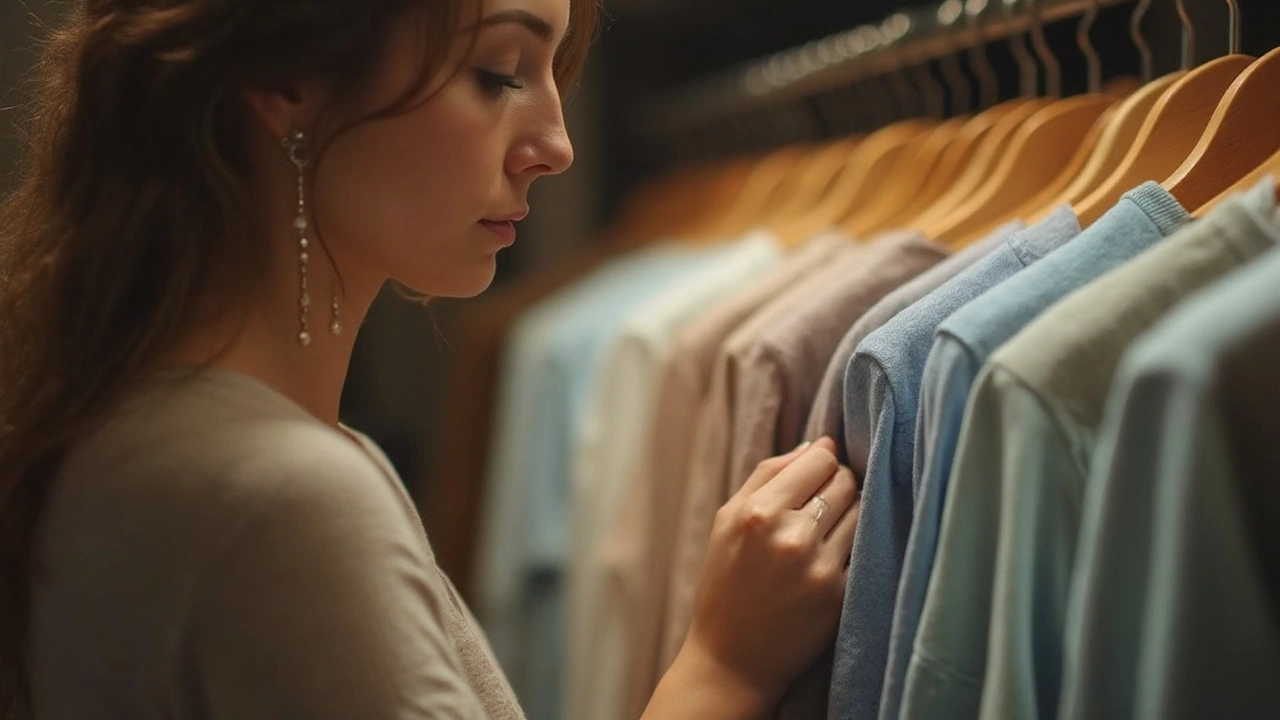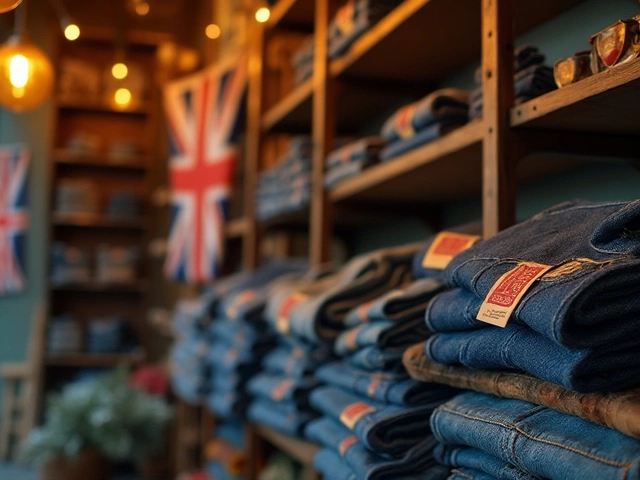Ever noticed how slipping into a tight t-shirt can instantly change how you feel? There's more going on here than just fabric clinging to your skin. Wearing well-fitted shirts actually makes people look sharper, more athletic, and surprisingly, a lot more confident—all before anyone says a word.
The first trick is all about lines. A tight shirt trims down those extra folds of fabric that usually bunch up and make you look sloppy. It smooths everything out, making your shoulders, chest, and arms stand out in the right ways. There's a reason your gym-fanatic friend lives in snug tees: they show off the work without a flex.
- The Psychology of Fit
- Body Shape and Highlighting Strengths
- The Right Tight: Fit Versus Squeeze
- Fabric Matters More Than You Think
- Making Tight Shirts Work for You
The Psychology of Fit
The way a tight shirt fits can totally mess with your head—in a good way. Studies from places like Princeton’s Social Cognition Lab show that we judge someone’s confidence and social status within seconds, mostly by looking at what they wear and how it fits. When you rock a well-fitted tee, people often see you as more put together and self-assured, even if you didn’t style your hair that day.
Here’s something even more interesting: wearing a snug shirt tends to boost your own confidence too. Psychologists at Northwestern once called this the "enclothed cognition" effect. What does that mean? Basically, the clothes you wear change how you feel about yourself and even how you act. Slide into a properly fitted t-shirt and you might stand a little taller, make more eye contact, and feel, well, cooler.
People aren’t just attracted to looks—they pick up on the energy you put out. If you feel comfortable and sharp, chances are, that’s how others will see you. Tight shirts can signal things like discipline (hello, gym time), self-care, and paying attention to style, all of which rank high in first impressions.
Pair that emotional boost with the practical side—no loose, floppy fabric to distract from your shape—and you get a shirt that works for you both mentally and socially. Turns out, that myth about “dress for success” really has some truth behind it.
Body Shape and Highlighting Strengths
Here’s the blunt truth: not all shirts—or bodies—are built the same. The secret sauce behind why tight shirts usually look better is how they bring out your best features and cover up stuff you don’t want to show. A good fit draws the eye to your shoulders and chest, giving you a more athletic shape, even if you haven’t touched a dumbbell in years.
Tight tees create a ‘V’ effect for most guys by hugging the chest and upper arms but tapering around the waist. That visual trick alone makes you appear stronger and slimmer all at once. As Annie Lee, editor of a popular men’s style blog, puts it:
“A shirt that hugs your torso and sits right on your shoulders works like a subtle highlight reel for your physique—people notice your strengths without even realizing it.”
Don’t think you need a bodybuilder’s build to pull this off. Even for dudes with dad bods, fitted shirts cut down on puffiness and help clothes sit better across the stomach. Baggy tees do the opposite—they add volume where nobody really wants it.
Check out how styles actually measure up. A 2023 online survey by FitCheck found that 74% of people said close-fitting shirts made wearers look more confident and put together, regardless of body type.
| Shirt Type | Perceived Confidence | Body Shape Enhancement |
|---|---|---|
| Loose T-Shirt | 32% | No |
| Tight Shirt | 74% | Yes |
If you want a shirt to work for you, here’s what to focus on:
- Pick a tee that sits flat on your shoulders—no droopy sleeves allowed
- Look for shirts that follow your body lines, but aren’t pulling tight around your stomach
- Choose fabrics with a little stretch so they adapt to your shape without constricting
At the end of the day, a well-fitted t-shirt is about playing up what you like—not hiding what you don’t. The goal is to frame your build, whatever it may be, and let the shirt do the talking.

The Right Tight: Fit Versus Squeeze
Here’s where a lot of people mess up when shopping for tight shirts. There’s a huge difference between a shirt that fits and one that just squeezes everything together. Fit is about following your body’s natural shape, while squeeze means your shirt is fighting your body at every seam—usually not a good look, and definitely not comfortable.
The main thing you want from your t-shirts is a close fit, not a vacuum seal. How do you spot the difference? Start with these simple checks:
- The seams at the shoulders should line up right where your shoulder bone ends. If they’re halfway to your neck, size up. If they’re falling down your arm, they’re too loose.
- The chest and arms should hug but not strangle you. If the sleeves are cutting into your biceps or you see lines from the fabric stretching, it’s time to let go of that shirt.
- There should be no big gaps around the waist, but you shouldn’t see the outline of your belly button through the fabric, either.
- You should be able to grab about an inch of fabric at your sides. Any less and your shirt’s glued on; more than that and it’s just baggy.
According to a 2023 survey by a leading online retailer, around 64% of men admit to wearing fit clothing that’s actually too tight. That usually leads to shirts losing shape faster and looking worn out after just a few washes. No one wants their brand-new tee to go see-through after a month.
| Sign | Fit | Squeeze |
|---|---|---|
| Shoulder seam location | Right at edge | Too high or low |
| Sleeve feel | Snug but comfy | Restrictive or cutting in |
| Torso fit | Follows shape | Shows every detail |
| Belly outline visible | No | Yes |
So don’t chase the tightest shirt out there. The best tight shirts show off your style and shape, while giving you room to breathe (and eat a burger). Check your fit in the mirror, move your arms, and if you feel trapped, try the next size up. The right tight is always about comfort first and looks a very close second.
Fabric Matters More Than You Think
It’s not just about picking any tight shirt off the rack. The fabric you choose totally changes the game when it comes to looking good in tight shirts. Some fabrics cling in all the wrong places, while others hug your shape just enough for a polished look. If you want a shirt that looks killer and feels comfortable, you need to pay serious attention to the tag.
Cotton is the go-to for a reason. It’s breathable, soft, and usually forgiving even in a snugger fit. But not all cotton is made equal. Ringspun and combed cotton are softer and last longer, while regular cotton is cheaper but can lose its shape fast.
Now, let’s talk blends. Adding a bit of spandex (look for 3-5%) or polyester to your t-shirts helps them keep their shape and bounce back after washes. Too much spandex, though, and you’ll get a shiny, workout-gear vibe, which isn’t for everyone.
Here’s how some common fabrics stack up for tight shirts:
| Fabric | Pros | Cons |
|---|---|---|
| Cotton | Breathable, natural, comfy | Shrinks if not pre-shrunk, can lose shape |
| Cotton/Spandex Blend | Good stretch, holds fit, less baggy | Can look shiny, sometimes tight in wrong spots |
| Polyester Blend | Resists wrinkles, dries fast, durable | Not as breathable, can smell faster |
If you sweat a lot or live somewhere hot, those synthetic blends dry super-fast but can make you feel sticky. For most people, a cotton shirt with a hint of stretch is your safest bet for an all-day, fitted look. Always check the care instructions—tight shirts can lose shape if you wash and dry them on high heat.
Trying on different fabrics helps you figure out what hugs your body best. Pay attention to how it feels around the arms and shoulders. You want a tight shirt that snaps back after a wash, not one that turns into a sloppy mess after a couple of wears.

Making Tight Shirts Work for You
If you’re set on rocking tight shirts, you want them to actually look good—not like you borrowed a younger sibling’s tee. The goal is a fit that hugs your body but still lets you breathe and move. Here’s how to nail it:
- Size is everything. Don’t just grab your usual size and hope for the best. Sizing varies by brand, so always check the sizing chart and, if possible, try the shirt on. If it’s leaving red marks on your skin or you’re sucking in your gut, go a size up.
- Check the shoulder seams. The seams should sit right on the edge of your shoulders. If they’re too high up or falling onto your arms, the fit isn’t right.
- Look at the sleeves. For most tight shirts, the sleeves should lightly hug your arms without cutting off circulation. A good test: you should be able to pinch about half an inch of fabric.
- Watch the length. Your t-shirt should land somewhere between the middle of your fly and a couple inches below your belt. Too short, and you’ll be tugging it all day. Too long, and you get the nightgown effect.
Here’s a quick run-down of what people notice most in a tight shirt:
| Detail | Impact |
|---|---|
| Shoulder Fit | Defines upper body, makes posture look better |
| Sleeve Grip | Highlights arms; can make biceps look bigger |
| Chest Contour | Shows shape, adds a fit vibe |
| Waist Taper | Can make your waist look slimmer |
One last thing: don’t cheap out on fabrics. Shirts with a bit of stretch (a cotton and elastane blend is perfect) adjust better to your body. They’re more comfortable and don’t lose shape after a wash. A good-fit, stretchy t-shirt will last longer and save you from the baggy look that comes after a few rounds in the laundry.
If you ever feel like your shirt is showing a little more than you want, layering is your friend. Toss a denim or bomber jacket on top, and you’ve got style points without feeling exposed.





